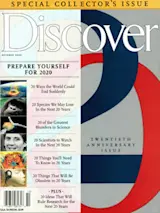Good Science, Bad Science I was severely disappointed with the August issue of Discover. If one defines intelligence as critical, evidence-based thinking, then your editorial board and reporters are deficient in this characteristic. Your articles "Worrying About Milk" and "Heresy" are devoid of the applications of scientific thinking that must be exercised by any magazine purporting to be a scientific publication. It appears that you do not appreciate the difference between causation and correlation. I expect at least that from my sources of scientific information. These articles should have appeared in journals that report advances in the fantasy world of ESP, where accurate scientific studies are not necessary.
Robin Oxman, M.D. Huntington Beach, California
Kudos on your daring August issue! Would that all science magazines reserved some space for "news that challenges comfortable ideas and accepted wisdom." The importance of agitation in the scientific community (often funded by private interests) ...














